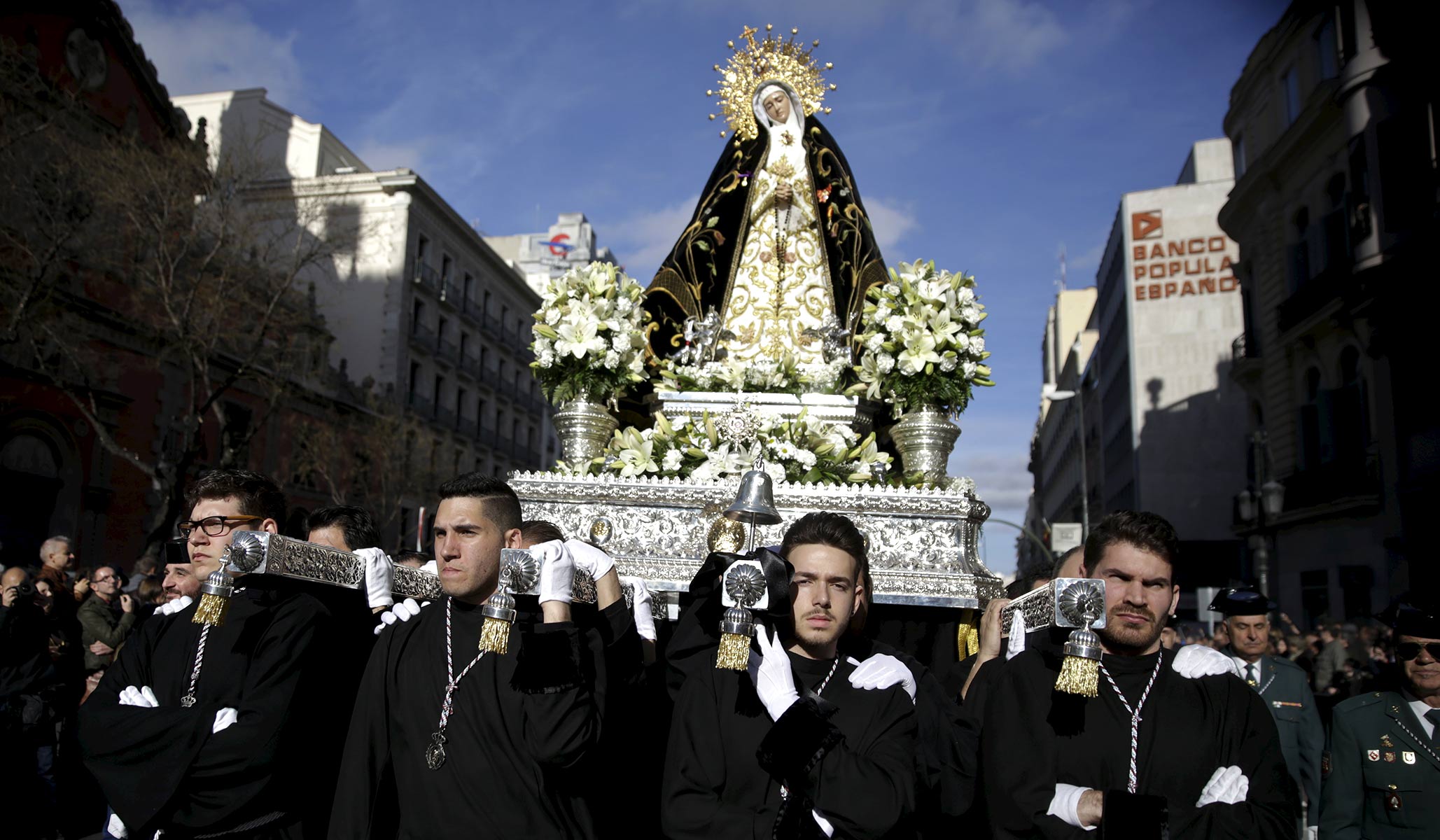


NRPLUS MEMBER ARTICLE I n the account of Saint Cyprian’s martyrdom, the Acta Prconsularia records how the first Christians carried in procession the bodies of those executed for defending the name of Christ. They did so with prayer, singing hymns of victory, “per noctem sublatum cum cereis et scolacibus” (“throughout the night, borne with candles and torches”) from the place of martyrdom to the tomb. Often they did it in secret.
To prevent those traditions from stoking a revival of Christianity, executioners often tried to find methods that would leave as few mortal remains of the martyrs as possible. Christians revered every last bone of every one of them. Today these remains are known as holy relics. Those prayer processions of the first Christians marked in some way the path of those that are conducted every Easter in Catholic communities worldwide, most notably in Italy, Spain, and some Latin-American countries.
The origins of modern-day Spanish processions, which gather millions of people in towns and cities throughout the country, can be attributed to the convergence of several factors: the rise of religious brotherhoods, the Council of Trent, and the popularity of “autos sacramentales,” theatrical and almost always allegorical representations of the mystery of the Eucharist.
Let us not forget that medieval Christianity was communitarian. The nature of the religiosity of the era led the faithful to honor Jesus’s human nature, not only his divinity, and hence the desire for public exposition of the faith, for the glorification of the cross in the streets.
In Europe, the guilds were in charge of the theatrical representations, the autos sacramentales. In the religious performances in medieval churches, real actors were gradually replaced with images in cardboard and cloth and, later, in wood, bronze, plaster, and marble. In the 16th century, autos sacramentales began to be performed in the streets. A century later, during the Counter-Reformation, the processions developed, linked to Easter through the expansion of the penitential spirit of the Franciscan order.
The Cofradía de la Santa Caridad (Brotherhood of Holy Charity), based in Toledo, is the oldest such society, dating back to 1085. It was created by King Alfonso VI, to provide Christian burial to those who had died during his siege of the city, which had been under the rule of a Berber Muslim dynasty. Today 3 million people participate in approximately 10,000 such confraternities throughout Spain. They process through the streets at this time of year, carrying holy images.
The Easter processions, like all expressions of popular religious devotion, had to be amended by the church on more than one occasion. Authorities sought to curb excesses. In the 18th century, Charles III banned the disciplinantes, penitents who would flog themselves during processions.
Both the religious images and the processions of Easter and, 60 days later, of the Feast of Corpus Christi were fundamental in the missionary work of Dominicans and Franciscans, especially in remote rural areas, where such demonstrations helped the faith to reach the people in the most engaging way possible. More features were introduced in the 19th century, and what developed as a spontaneous expression of the desire to physically accompany Christ suffering his torture and execution in the streets became in time a religious, cultural, and tourist attraction backed by an enthusiastic public administration.
In today’s Easter processions in Spain, most of the elements I have mentioned coexist. They continue to be Christocentric representations, of penitential character, and with apostolic intent. Their objective is to glorify God, promote of the faith, demonstrate examples of how we might live the mysteries of Lent and Easter. Cultural and religious elements are integrated in wholesome public events. Governments have been charged with protecting them as a “cultural heritage,” while the church benefits from the platform they provide for the attraction of religious practice, at least during the days dedicated to the commemoration of the passion of Christ and of his resurrection.
In 2017, I had just begun as an adviser to the Ministry of Culture during Mariano Rajoy’s term as prime minister, when the government moved to protect public Easter celebrations. Some had wanted to boycott or even cancel the tradition, as their predecessors on the Spanish left had done in 1932. The Second Republic had banned public religious performances and incited its militias to murder Christians and burn churches. The Ministry of Culture in 2017 granted Holy Week in Spain the important protective title “Representative Manifestation of Intangible Cultural Heritage.”
The processions and celebrations, both in public and inside churches, that guide the faithful in Spain throughout Lent and Easter help them to affirm their relationship with Christ and to experience their faith in a dimension unique to that time of year. From childhood, year after year, millions of people participate in such reenactments. Many of them are not otherwise observant of the Catholic faith. Easter is their sole contact with God throughout the year.
So no one is surprised to see atheists or famous actors crying when they see the image of the crucified Christ passing in front of their balcony, or to see them carrying on their own shoulders the same image, of the Sorrowful Virgin, that their parents carried when they were children. To witness their emotion is itself a moving experience.
It is no coincidence that this Easter phenomenon is also the gateway to many conversions in a country that, although it has lost the religious fervor of generations past, continues to see churches fill up on these critical days in March or April, as people follow Christ to the foot of that somber and bare wooden cross. You have to experience it to understand it. Easter in Spain is, without a doubt, a breath of hope for all Christians. God is present.
